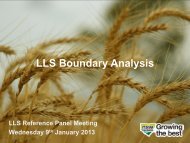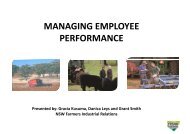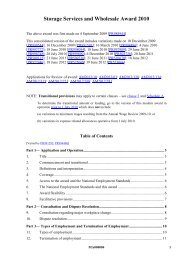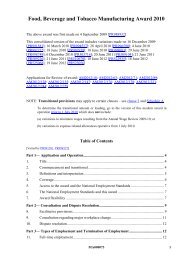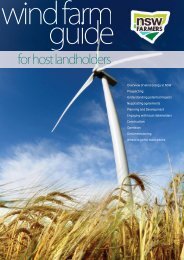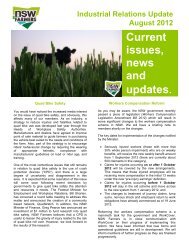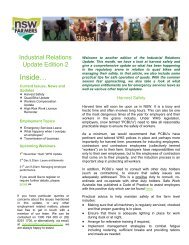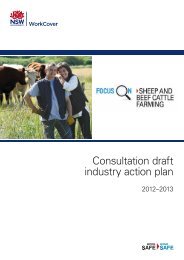Chapter 6 – Negotiating an agreement - NSW Farmers Association
Chapter 6 – Negotiating an agreement - NSW Farmers Association
Chapter 6 – Negotiating an agreement - NSW Farmers Association
- No tags were found...
Create successful ePaper yourself
Turn your PDF publications into a flip-book with our unique Google optimized e-Paper software.
Wind Farm Guide for Host L<strong>an</strong>dholders20
<strong>Negotiating</strong> <strong>an</strong> <strong>agreement</strong> 6This Section outlines the different types of <strong>agreement</strong>sl<strong>an</strong>dholders may enter into with developers, <strong>an</strong>d thecommercial considerations which commonly need to be takeninto account when negotiating <strong>an</strong> <strong>agreement</strong>.6.1 Obtaining legal <strong>an</strong>d fin<strong>an</strong>cial adviceInformation in this section is only indicative <strong>an</strong>d each windfarm development is different. It is highly recommendedthat you get independent legal <strong>an</strong>d fin<strong>an</strong>cial guid<strong>an</strong>cefrom qualified personal with experience in wind farmdevelopments.Your developer may agree to reimburse the expenses youincur in obtaining this independent advice.6.2 Typical contract arr<strong>an</strong>gementsThere are a r<strong>an</strong>ge of different legal <strong>agreement</strong>s which c<strong>an</strong>be used at different stages of wind farm developments.However the most typical arr<strong>an</strong>gements are summarisedin Figure 13 below, whereby l<strong>an</strong>dholders enter into initialaccess <strong>agreement</strong>s <strong>an</strong>d/or option to lease <strong>agreement</strong>s duringthe early stages of development, leading to <strong>an</strong> eventuallease <strong>agreement</strong> once the development is approved <strong>an</strong>dconstruction begins.SITE SELECTIONPROJECTFEASIBILITYDETAILEDASSESSMENTPLANNINGAPPLICATIONCONSTRUCTIONOPERATIONDECOMMISSIONINGFigure 13 Typical contract arr<strong>an</strong>gementsACCESS AGREEMENTOPTION TO LEASE AGREEMENTLEASE AGREEMENT6.2.1 Access <strong>agreement</strong>sAn access <strong>agreement</strong> is usually a short term <strong>agreement</strong> toallow the developer site access to conduct wind monitoring<strong>an</strong>d feasibility studies. This <strong>agreement</strong> is optional <strong>an</strong>ddevelopers might w<strong>an</strong>t to move directly to <strong>an</strong> option to lease<strong>agreement</strong> which c<strong>an</strong> provide more certainty (see Section6.2.2 below).6.2.2 Option to lease <strong>agreement</strong>sAn option to lease <strong>agreement</strong> will normally allow a developerto access the property to assess the wind farm feasibility with<strong>an</strong> option to move into a lease <strong>agreement</strong> at a later stage.Lease <strong>agreement</strong>s are usually triggered when developerscommence construction on the site.An option to lease <strong>agreement</strong>s is usually binding on thel<strong>an</strong>dholder following execution, whereas developers maywithdraw at <strong>an</strong>y stage before construction commences (whenthe lease becomes binding). L<strong>an</strong>dholders should keep in mindthat there may be little certainty about when (or if) a windfarm developer will be gr<strong>an</strong>ted pl<strong>an</strong>ning approval <strong>an</strong>d beginconstruction.Option to lease <strong>agreement</strong>s c<strong>an</strong> be negotiated at <strong>an</strong>y stage ofdevelopment between site selection <strong>an</strong>d pl<strong>an</strong>ning application.Agreement c<strong>an</strong> contain as much or as little detail as thel<strong>an</strong>dholder <strong>an</strong>d developer wish to agree upon, for inclusionin the final lease. A common approach is for l<strong>an</strong>dholders <strong>an</strong>ddevelopers to agree on the key conditions, while leaving someroom to finalise minor operational issues as the developmentprogresses. This approach provides l<strong>an</strong>dholders with a level ofcertainty about the final value of the lease, pending the resultsof feasibility assessments.Other l<strong>an</strong>dholders have chosen to negotiate <strong>an</strong> option tolease <strong>agreement</strong> covering all conditions of the eventual lease,thereby removing the need for further negotiation.The precise wording of the <strong>agreement</strong> is a matter fornegotiation between the l<strong>an</strong>dholder <strong>an</strong>d the developer.More commonly the developer prepares the first draft ofthe <strong>agreement</strong>, although in some inst<strong>an</strong>ces l<strong>an</strong>dholdershave preferred to take responsibility for this drafting(notwithst<strong>an</strong>ding the time <strong>an</strong>d expense this may entail).Once a first draft has been prepared either party c<strong>an</strong> proposefurther revisions before the <strong>agreement</strong> is finalised - subjectto some legal constraints, the terms of the <strong>agreement</strong> are amatter for commercial negotiation between l<strong>an</strong>dholder <strong>an</strong>dwind farm developer.Wind Farm Guide for Host L<strong>an</strong>dholders21
Review <strong>an</strong>d expiry of <strong>agreement</strong>sAs noted above in Section 4.3 the terms of the option to leasenormally prevent the l<strong>an</strong>dholder from negotiating with otherwind farm developers until the option to lease period expires.The length of the option to lease period is one of the aspectsthat c<strong>an</strong> be negotiated between parties.Ch<strong>an</strong>ges to proposed location of wind turbinesDevelopers will often reserve the right to adjust the finalposition of turbines. This process is commonly referred to as‘micro-siting’.Commonly pl<strong>an</strong>ning approvals allow developers to moveturbine locations by up to 100m so long as the environmentalimpacts do not ch<strong>an</strong>ge.The extent to which a L<strong>an</strong>dholder has control over micrositingwill depend on the terms of the legal <strong>agreement</strong>sbetween the L<strong>an</strong>dholder <strong>an</strong>d the developer for developmentof the wind farm.6.2.3 Lease <strong>agreement</strong>sBefore construction commences the option to lease willnormally be exercised <strong>an</strong>d the wind farm developer will enterinto a lease <strong>agreement</strong> with the l<strong>an</strong>dholder. Lease <strong>agreement</strong>swill normally be for the life of the wind farm (generally 25years with <strong>an</strong> option for renewal) <strong>an</strong>d will cover the turbine,substation <strong>an</strong>d <strong>an</strong>cillary building areas. Lease <strong>agreement</strong>swill normally only be entered into once construction has beenconfirmed.There is no st<strong>an</strong>dard wind farm lease <strong>agreement</strong>; however atypical lease will confer the following rights <strong>an</strong>d obligationsfor l<strong>an</strong>dholders (Table 1).Table 1Common l<strong>an</strong>dholder rights <strong>an</strong>d obligations withinlease <strong>agreement</strong>sL<strong>an</strong>dholderRights • To continue farming operations in <strong>an</strong>d around the site once construction is complete (subject to certain restrictions)• To sell or sub-let the property (under certain conditions)• To review information used to determine remuneration (e.g. electricity generation)• To have site security <strong>an</strong>d biosecurity protocols protected• To have certain input into project design (e.g. fences <strong>an</strong>d l<strong>an</strong>eways)• To have the site rehabilitated following decommissioningObligations • To accommodate the construction <strong>an</strong>d ongoing operation of the wind farm facility (e.g. providing access to property,removing livestock where necessary for construction etc).• Not to enter into arr<strong>an</strong>gements with other wind farm developers• Not to develop high structures around the wind turbines (to avoid disturbing the air flow)• Not to disclose details of the <strong>agreement</strong> (e.g. payment per turbine).22 Wind Farm Guide for Host L<strong>an</strong>dholders
“Get a good lawyer with experience in commercialcontracts, it will be money well spent”—Comment from wind farm l<strong>an</strong>dholder (2012 Focus Group)6.3 Other types of legal <strong>agreement</strong>s <strong>an</strong>d arr<strong>an</strong>gementsIn certain circumst<strong>an</strong>ces, other types of <strong>agreement</strong>s <strong>an</strong>darr<strong>an</strong>gements c<strong>an</strong> be entered into between l<strong>an</strong>dholders <strong>an</strong>ddevelopers. These include:• l<strong>an</strong>d purchase;• easements for support infrastructure;• crown l<strong>an</strong>d development <strong>agreement</strong>s; <strong>an</strong>d• community wind farm developments.6.3.1 L<strong>an</strong>d purchaseOccasionally developers may purchase properties requiredfor development. Most commonly this will be where the lot issmall <strong>an</strong>d/or the proposed infrastructure takes up most of thelot. Generally, however, developers lease rather th<strong>an</strong> own windfarm sites.6.3.2 Easements for support infrastructureEasement <strong>agreement</strong>s may be entered into to allow thepassage of cables, tr<strong>an</strong>smission lines or access roads through al<strong>an</strong>dholder’s property.6.3.3 Crown l<strong>an</strong>d development <strong>agreement</strong>sFor a development to proceed on l<strong>an</strong>d currently leased fromthe Crown under either the Crown L<strong>an</strong>ds Act 1989 or theWestern L<strong>an</strong>ds Act 1901 the developer will need to obtain:• the Crown’s position in regard to progressinginvestigation for a Wind Farm; <strong>an</strong>d• consent to allow the development under cover of theexisting lease OR by way of a new Special Purposes Leasefrom the Crown.A Special Purposes Lease will not be issued by the Crownunless the developer obtains the written consent of theexisting lessee (normally the farmer with the right to graze onthat l<strong>an</strong>d).An <strong>agreement</strong> just between a lessee <strong>an</strong>d a developer toprovide consent will not, in legal terms, be a lease <strong>an</strong>d will notauthorise the development to be carried out on Crown L<strong>an</strong>d.The <strong>agreement</strong> could, however, be drafted to address thesame types of issues that a lease <strong>agreement</strong> would normallycover for development occurring on private l<strong>an</strong>d.Easements may be implemented as part of a lease <strong>agreement</strong>with host l<strong>an</strong>dholders, or as a st<strong>an</strong>d-alone arr<strong>an</strong>gement withneighbouring l<strong>an</strong>dholders whose property is required forsupport infrastructure.Easements are registered on the Title to the property, withL<strong>an</strong>d <strong>an</strong>d Property Information in <strong>NSW</strong>, <strong>an</strong>d are automaticallytr<strong>an</strong>sferred when l<strong>an</strong>d ch<strong>an</strong>ges h<strong>an</strong>ds.Figure 14 Sunrise at Waterloo Wind Farm, SA 17Wind Farm Guide for Host L<strong>an</strong>dholders23
Silverton Wind FarmThe Silverton Wind Farm (stage 1 <strong>an</strong>d 2), located north of BrokenHill, has been approved but not yet constructed. The former L<strong>an</strong>d<strong>an</strong>d Property M<strong>an</strong>agement Authority (LPMA) negotiated the legal<strong>an</strong>d operational framework that will allow the proposed wind farmto be established. Agreements were reached by the LPMA bothwith the wind farm proponent as well as the four current westernl<strong>an</strong>ds lessees affected by the development.The consents from the existing pastoral lessees provide themech<strong>an</strong>ism for a Special Purposes Lease (parallel lease) to beentered into between the LPMA <strong>an</strong>d the developer thus providingthe security of tenure the developer requires.LPMA negotiated <strong>an</strong> <strong>agreement</strong> for lease with the wind farmproponents, while the four pastoralists who currently lease westerndivision Crown l<strong>an</strong>d in the project area have agreed to the termsof consent deeds that provide their approval for the final specialpurpose lease to be entered into with the developer.As part of the process, the pastoral Lessees have also negotiatedOperational Agreements with the wind farm developer that set outthe details of how both parties will operate <strong>an</strong>d interact in regardto their respective activities on the same area of l<strong>an</strong>d.As a result the proponents will have secure <strong>an</strong>d guar<strong>an</strong>teed Crownleasehold title to the l<strong>an</strong>d <strong>an</strong>d it will occupy the Crown l<strong>an</strong>d undera parallel Crown l<strong>an</strong>d special purpose lease.Parallel leases, or two leases on the one parcel of l<strong>an</strong>d is permittedfollowing ch<strong>an</strong>ges to the Western L<strong>an</strong>ds Act <strong>an</strong>d Crown L<strong>an</strong>ds Actin 2011.In terms of compensation, some leaseholders have utilised legalservices to assist them to negotiate.6.3.4 Community wind farm developmentsCommunity org<strong>an</strong>isations c<strong>an</strong> also undertake their own winddevelopments, by funding <strong>an</strong>d/or leading projects. Theseare commonly known as Community Renewable Energy(CRE) projects. There are a variety of different communityownership <strong>an</strong>d participation models for community wind farmdevelopments. Internationally there have been “hundreds ifnot thous<strong>an</strong>ds” of CRE projects. 18There is currently one operational large-scale communitywind farm development in Australia, the 4.1MW, two turbineHepburn Wind Farm at Leonards Hill, Victoria. There arealso a number of other community wind farm developmentscurrently under investigation, including in <strong>NSW</strong>.The legal arr<strong>an</strong>gements between community wind farmdevelopments <strong>an</strong>d l<strong>an</strong>dholders are generally similar to thearr<strong>an</strong>gements l<strong>an</strong>dholders have with commercial wind farmdevelopments.6.4 Group negotiationProposed wind farms are usually spread across a number ofseparately owned parcels of l<strong>an</strong>d, requiring developers todeal with multiple l<strong>an</strong>dholders. This situation provides <strong>an</strong>opportunity for l<strong>an</strong>dholders to negotiate collectively with thewind farm developer. This type of group negotiation normallyoccurs with the aim of reaching a collective <strong>agreement</strong> wherethe l<strong>an</strong>dholders will each host turbines on the same or similarterms.As with <strong>an</strong>y type of group negotiation there c<strong>an</strong> beadv<strong>an</strong>tages <strong>an</strong>d disadv<strong>an</strong>tages with group negotiation thatneed to be weighed up carefully by each member.If l<strong>an</strong>dholders decide to negotiate as a group, carefulm<strong>an</strong>agement of negotiations is required. From the outsetgroups should decide the following:• What will be negotiated - the actual lease <strong>agreement</strong>sor just <strong>an</strong> overarching <strong>agreement</strong> on key matters (e.g.revenue) that individual leases will then be separatelynegotiated under? Even where group negotiation occurs,some things c<strong>an</strong> be left to individual negotiations withoutcompromising the integrity of group negotiations (e.g.access rights).24 Wind Farm Guide for Host L<strong>an</strong>dholders
“Group negotiation c<strong>an</strong> be difficult to m<strong>an</strong>age but wefound it was absolutely worthwhile, you just need to setsome clear ground rules, m<strong>an</strong>age expectations <strong>an</strong>d keepmembers informed at all stages.”—Comment from wind farm l<strong>an</strong>dholder (2012 Focus Group)• Who will negotiate? Will everyone be at the negotiatingtable or just a group of representatives? If representativesare to negotiate, what authority do they have <strong>an</strong>d howwill they consult with the group?• How binding will the negotiated <strong>agreement</strong> be? C<strong>an</strong>L<strong>an</strong>dholders opt out <strong>an</strong>d negotiate separately, or are theyobliged to proceed with the negotiated <strong>agreement</strong>?• Will the group prepare the first draft of the lease<strong>agreement</strong> or will this be the developer’s responsibility?• What will happen if the development proposal is ch<strong>an</strong>ged<strong>an</strong>d the location/number of turbines on the differentl<strong>an</strong>dholders l<strong>an</strong>d parcels is ch<strong>an</strong>ged?• Is there a minimum number of turbines that must bedeveloped for the <strong>agreement</strong> to be binding?• How will payment be apportioned between propertieswith different levels of suitability for wind turbines,particularly different wind speeds? Will payment beperform<strong>an</strong>ce related or will there be a st<strong>an</strong>dardisedpayment regardless of perform<strong>an</strong>ce?• What happens when l<strong>an</strong>d ownership ch<strong>an</strong>ges? Does the<strong>agreement</strong> run with the l<strong>an</strong>d? Will additional l<strong>an</strong>dholdersbe allowed to become parties to the <strong>agreement</strong> once it isfinalised with the developer?• How will costs incurred by the group (not covered bythe developer) be apportioned between members of thegroup?If you wish to proceed with l<strong>an</strong>dholder group negotiations it ishighly recommended that you seek expert legal advice.6.5 Fin<strong>an</strong>cial considerations <strong>an</strong>d restrictions6.5.1 Different payment structuresL<strong>an</strong>dholder payments are a key matter for negotiations. Criteriathat payments could be based on include:• number of turbines constructed;• turbine “name-plate” generation capacity (MW);• amount of electricity generated by wind farm (MWh);• windfarm footprint (m2);• revenue generated (“royalty”) (% of revenue);• flat fee; or• a combination of the above (or other) factors.If remuneration is based on a variable factor (such as MWhgenerated), the amount you will receive will be subjectto project perform<strong>an</strong>ce. These arr<strong>an</strong>gements c<strong>an</strong> allowl<strong>an</strong>dholders to benefit in ch<strong>an</strong>ged circumst<strong>an</strong>ces (e.g. ifturbines are upgraded to a higher capacity).L<strong>an</strong>dholders should ensure they have access to the data that<strong>an</strong>y perform<strong>an</strong>ce payment calculation is based on, in order toverify payment amounts.The index that payments are linked to, c<strong>an</strong> also signific<strong>an</strong>tlyaffect the value of leases. Payments may be indexed toeconomic growth generally, or to particular markets relev<strong>an</strong>tto wind generation (e.g. electricity pricing). The l<strong>an</strong>dholder<strong>agreement</strong> will need to specify the base year that indexedvalues are calculated from.Small differences in payment terms c<strong>an</strong> have a signific<strong>an</strong>teffect when compounded over the full term of the operationallease.Timing for payments c<strong>an</strong> also be import<strong>an</strong>t. Because theupfront capital costs of development are signific<strong>an</strong>t, somedevelopers may prefer to establish contracts which offerl<strong>an</strong>dholders higher payments further along the developmentlife cycle (e.g. in the second decade).Finally, l<strong>an</strong>dholder <strong>agreement</strong>s c<strong>an</strong> have tax <strong>an</strong>d fin<strong>an</strong>cialimplications due to the additional income that hosting windturbines c<strong>an</strong> generate. Host l<strong>an</strong>dholders may find it helpful toinvolve their b<strong>an</strong>k or professional advisor in the negotiationprocess, to ensure their fin<strong>an</strong>ces are duly considered.6.5.2 How much c<strong>an</strong> I expect?One of the challenges for l<strong>an</strong>dholders in negotiating<strong>agreement</strong>s is that it c<strong>an</strong> be difficult to know how muchremuneration they c<strong>an</strong> reasonably expect to negotiate.Remuneration varies signific<strong>an</strong>tly <strong>an</strong>d depends on a number offactors including:• the expected perform<strong>an</strong>ce of turbines (wind speed);• the location of the site, particularly the dist<strong>an</strong>ce frommajor tr<strong>an</strong>smission lines;• competition for the right to place turbines on the site;• the import<strong>an</strong>ce of the particular site to the overall projectsuccess; <strong>an</strong>d• market practice.Wind Farm Guide for Host L<strong>an</strong>dholders25
“Having a steady, reliable income from our wind turbines hasbeen f<strong>an</strong>tastic for our farm business. We’re now able to makelong-term pl<strong>an</strong>s to improve our property, knowing that wec<strong>an</strong> survive short-term weather <strong>an</strong>d commodity cycles.”—Comment from wind farm l<strong>an</strong>dholder (2012 Focus Group)As noted in Section 6.4 fin<strong>an</strong>cial outcomes may be improvedwhere l<strong>an</strong>dholders work together to boost their bargainingposition.L<strong>an</strong>dholders should think carefully before signing <strong>an</strong>y<strong>agreement</strong> which includes a confidentiality clause, as this mayaffect their ability to discuss remuneration with neighbours orbargain collectively. <strong>NSW</strong> <strong>Farmers</strong> is able to put members incontact with other host l<strong>an</strong>dholders to discuss remuneration(see contact details in 11.1).of the 45 sales investigated did not show <strong>an</strong>y reductions invalue, while five properties were found to have lower th<strong>an</strong>expected sale prices (though the study could not confirm thatthese results were a direct result of the wind farm, <strong>an</strong>d nota response to other factors). The study concluded that “themajority of wind farms erected in Australia appear to have hadno qu<strong>an</strong>tifiable effect on l<strong>an</strong>d values”.6.5.5 Restrictions on the sale <strong>an</strong>d/or futuredevelopment of l<strong>an</strong>dL<strong>an</strong>dholders should be aware of how the wind farmdevelopment may affect the sale or development of their l<strong>an</strong>din the future.Sale of l<strong>an</strong>dThe wind farm lease <strong>agreement</strong> will be registered on the titleof the l<strong>an</strong>dholder, <strong>an</strong>d should a tr<strong>an</strong>sfer of the property occurthrough sale the purchaser will be required to agree to theterms of the operational lease <strong>agreement</strong>.Pl<strong>an</strong>ning restrictionsFigure 15 Clements Gap Wind Farm, SA 196.5.3 Impacts on host l<strong>an</strong>d valueFew studies in Australia have specifically assessed thepotential impact of wind farm development on the value ofhost l<strong>an</strong>d. However a recent Senate inquiry 20 concluded that:The value of properties that are hosts to wind turbines shouldincrease provided of course that the rights to rentals for theturbines are tr<strong>an</strong>sferable with the sale of the property.Host l<strong>an</strong>dholders may experience <strong>an</strong> increase in municipalrates, if the value of the turbine development becomesreflected in the value of the l<strong>an</strong>d asset. L<strong>an</strong>dholders shouldcontact their local council to discuss potential impacts.6.5.4 Impact on neighbouring l<strong>an</strong>d valuesA 2009 study commissioned by the <strong>NSW</strong> Valuer General 21assessed the potential impact of wind farms on nearby l<strong>an</strong>dparcels. The study considered the sale results of 45 l<strong>an</strong>dparcels adjoining 8 wind farms. The results showed that 40The installation of a wind farm may affect some futuredevelopment from occuring on the l<strong>an</strong>d. These restrictionswill depend on the particular local <strong>an</strong>d State developmentcontrols that apply to the site. Implications for futuredevelopment of the l<strong>an</strong>d should be taken into account whenagreeing to host turbines.Property subdivisionL<strong>an</strong>dholders who have <strong>an</strong> intention of subdividing their l<strong>an</strong>din the future, may w<strong>an</strong>t to investigate whether the proposedwind farm would not limit subdivision <strong>an</strong>d the potential forlocating a dwelling on subdivided lots where appropriate.Under s23F of the Convey<strong>an</strong>cing Act 1919, a pl<strong>an</strong> for a lease ofl<strong>an</strong>d for more th<strong>an</strong> 5 years (including <strong>an</strong>y options of renewal)constitutes a subdivision in terms of s4B of the EnvironmentalPl<strong>an</strong>ning <strong>an</strong>d Assessment Act 1979 <strong>an</strong>d s195(1) of theConvey<strong>an</strong>cing Act <strong>an</strong>d will consequently require subdivisionconsent. Wind farm leases do not normally trigger thisrequirement as they are treated by <strong>NSW</strong> L<strong>an</strong>ds <strong>an</strong>d PropertyInformation as being leases for premises rather th<strong>an</strong> l<strong>an</strong>d. 22Confirmation should, however, be sought that for a particularwind farm project subdivision consent will not be required.For more information contact the Titling <strong>an</strong>d Registry Services,<strong>NSW</strong> L<strong>an</strong>ds <strong>an</strong>d Property Information (1300 052 637).26 Wind Farm Guide for Host L<strong>an</strong>dholders
Property Vegetation Pl<strong>an</strong>sProperty Vegetation Pl<strong>an</strong>s (PVP) are voluntary, legally binding<strong>agreement</strong>s between a l<strong>an</strong>dholder <strong>an</strong>d the local CatchmentM<strong>an</strong>agement Authority (CMA) to enable certain types ofclearing. PVPs are commonly applied to the l<strong>an</strong>d title <strong>an</strong>dwill therefore tr<strong>an</strong>sfer with <strong>an</strong>y ch<strong>an</strong>ge of ownership. Theobligation to comply with PVP offset requirements falls on thel<strong>an</strong>dholder.An existing PVP may need to be varied if additional clearing ofnative vegetation is required to accommodate the proposedwind farm development. Therefore l<strong>an</strong>dholders with <strong>an</strong>existing PVP, or looking to introduce a PVP, should discuss <strong>an</strong>dnegotiate this with their developer.PVPs are issued under the Native Vegetation Act 2003 (NVAct). If a wind farm development is not State Signific<strong>an</strong>tDevelopment (SSD) (see Section 7.1 for more informationon what types of development are SSD) approval under theNV Act may be required for clearing that is required for theinstallation of the wind farm (including, particularly, theconstruction of access roads).Development restrictionsThe wind farm lease <strong>agreement</strong> may contain controls on thetypes of other development that c<strong>an</strong> occur on the l<strong>an</strong>d oncethe wind farm is installed. Restrictions on agroforestry, PVPs,blasting <strong>an</strong>d extractive mining are the most common. Theimpact of these restrictions on future development potentialwill be site dependent.6.5.6 L<strong>an</strong>d access issuesHost l<strong>an</strong>dholders c<strong>an</strong> negotiate <strong>an</strong>d specify in lease <strong>agreement</strong>sthe protocol for l<strong>an</strong>d access. Some contracts include provisionsfor stock grids, vehicle wash-down, sign in books, speed limits,marked vehicles, roadside weed control etc.In addition it is import<strong>an</strong>t to ensure that operators have publicliability insur<strong>an</strong>ce cover for <strong>an</strong>y property damage, e.g. fences,livestock etc. L<strong>an</strong>dholders may seek to have operators cover<strong>an</strong>y increase in farm insur<strong>an</strong>ce costs.6.6 Case Study: Charlie Prell, ‘Gundowringa’, CrookwellCharlie Prell is a grazier from Crookwell, near Goulburn <strong>NSW</strong>,who has more th<strong>an</strong> 10 years experience in having a wind farmestablished on his property.Charlie started to consider his property’s potential to host turbinesafter he watched a small 8 turbine wind farm (“Crookwell 1”)being developed on a neighbouring property in 1996.“I saw wind turbines as <strong>an</strong> opportunity to drought-proof myproperty, encourage economic development in the Crookwellregion <strong>an</strong>d also reduce carbon emissions”.Charlie started to have discussions with wind farm comp<strong>an</strong>iesaround 2000 <strong>an</strong>d 2001, including a number of wind farm brokerswho identify potential sites <strong>an</strong>d establish l<strong>an</strong>dholder <strong>agreement</strong>s.Eventually Charlie signed <strong>an</strong> <strong>agreement</strong> to lease in J<strong>an</strong>uary 2004.By mid-2004 the development application for the “Crookwell2” wind farm had been submitted <strong>an</strong>d almost a year laterthe application was approved, with 112 conditions attachedincluding a downgrading of capacity from 55 to 46 turbines.Crookwell 2 is currently under construction, with 46 turbinespl<strong>an</strong>ned. “M<strong>an</strong>y l<strong>an</strong>dholders don’t appreciate the time it c<strong>an</strong>take for a wind farm development to be designed, approved <strong>an</strong>dconstructed. A wind farm is a long term development <strong>an</strong>d needscareful consideration by all parties; however it is in l<strong>an</strong>dholder’sinterest to make sure their developer is committed to developingthe asset <strong>an</strong>d is making progress towards construction. This c<strong>an</strong>be achieved by building in milestone dates into <strong>agreement</strong>s”.“A wind farm is a long-term development <strong>an</strong>d needs carefulconsideration by all parties; however it is in the l<strong>an</strong>dholder’sinterest to make sure their developer is seriously committed toconstructing the wind farm <strong>an</strong>d is making progress towards thisconstruction. This c<strong>an</strong> be achieved by building milestone datesinto <strong>agreement</strong>s.”Charlie encourages potential host l<strong>an</strong>dholders to talk withother host l<strong>an</strong>dholders <strong>an</strong>d visit existing wind farms to shareexperiences <strong>an</strong>d to see <strong>an</strong>d experience wind farms first h<strong>an</strong>d.Charlie also believes it is import<strong>an</strong>t for l<strong>an</strong>dholders to be open<strong>an</strong>d honest with their neighbours about their pl<strong>an</strong>s, listen to theirconcerns <strong>an</strong>d be accommodating where possible.“Nine turbines were removed from our pl<strong>an</strong>, as a compromise toneighbours’ concerns.”Charlie is looking forward to having a secure passive incomesource which will help relieve production pressure on his farm,<strong>an</strong>d therefore allow him to take better care of his l<strong>an</strong>d, a betteroutcome for all.Charlie’s advice for potential host l<strong>an</strong>dholders:• engage a lawyer with experience in corporate contracts• visit a wind farm• have milestone dates inserted into your contract to ensure yourdeveloper is moving towards construction• don’t rush into signing a contract you are not completely happywith. Being approached me<strong>an</strong>s that you own <strong>an</strong> asset that issignific<strong>an</strong>t <strong>an</strong>d real.Wind Farm Guide for Host L<strong>an</strong>dholders27





